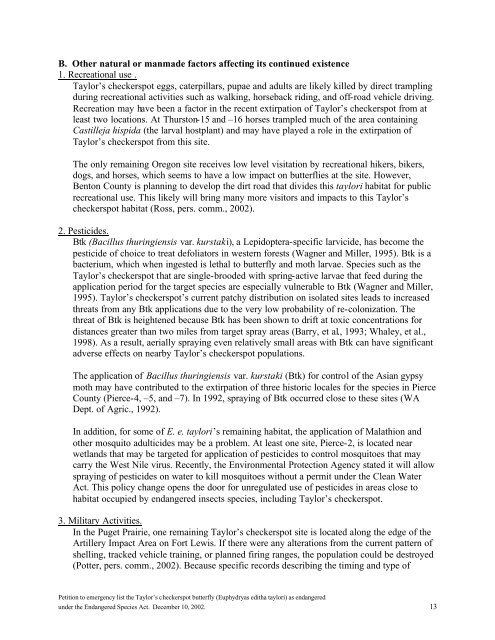petition to emergency list taylor's (whulge) checkerspot - The Xerces ...
petition to emergency list taylor's (whulge) checkerspot - The Xerces ...
petition to emergency list taylor's (whulge) checkerspot - The Xerces ...
You also want an ePaper? Increase the reach of your titles
YUMPU automatically turns print PDFs into web optimized ePapers that Google loves.
B. Other natural or manmade fac<strong>to</strong>rs affecting its continued existence<br />
1. Recreational use .<br />
Taylor’s <strong>checkerspot</strong> eggs, caterpillars, pupae and adults are likely killed by direct trampling<br />
during recreational activities such as walking, horseback riding, and off-road vehicle driving.<br />
Recreation may have been a fac<strong>to</strong>r in the recent extirpation of Taylor’s <strong>checkerspot</strong> from at<br />
least two locations. At Thurs<strong>to</strong>n-15 and –16 horses trampled much of the area containing<br />
Castilleja hispida (the larval hostplant) and may have played a role in the extirpation of<br />
Taylor’s <strong>checkerspot</strong> from this site.<br />
<strong>The</strong> only remaining Oregon site receives low level visitation by recreational hikers, bikers,<br />
dogs, and horses, which seems <strong>to</strong> have a low impact on butterflies at the site. However,<br />
Ben<strong>to</strong>n County is planning <strong>to</strong> develop the dirt road that divides this taylori habitat for public<br />
recreational use. This likely will bring many more visi<strong>to</strong>rs and impacts <strong>to</strong> this Taylor’s<br />
<strong>checkerspot</strong> habitat (Ross, pers. comm., 2002).<br />
2. Pesticides.<br />
Btk (Bacillus thuringiensis var. kurstaki), a Lepidoptera-specific larvicide, has become the<br />
pesticide of choice <strong>to</strong> treat defolia<strong>to</strong>rs in western forests (Wagner and Miller, 1995). Btk is a<br />
bacterium, which when ingested is lethal <strong>to</strong> butterfly and moth larvae. Species such as the<br />
Taylor’s <strong>checkerspot</strong> that are single-brooded with spring-active larvae that feed during the<br />
application period for the target species are especially vulnerable <strong>to</strong> Btk (Wagner and Miller,<br />
1995). Taylor’s <strong>checkerspot</strong>’s current patchy distribution on isolated sites leads <strong>to</strong> increased<br />
threats from any Btk applications due <strong>to</strong> the very low probability of re-colonization. <strong>The</strong><br />
threat of Btk is heightened because Btk has been shown <strong>to</strong> drift at <strong>to</strong>xic concentrations for<br />
distances greater than two miles from target spray areas (Barry, et al., 1993; Whaley, et al.,<br />
1998). As a result, aerially spraying even relatively small areas with Btk can have significant<br />
adverse effects on nearby Taylor’s <strong>checkerspot</strong> populations.<br />
<strong>The</strong> application of Bacillus thuringiensis var. kurstaki (Btk) for control of the Asian gypsy<br />
moth may have contributed <strong>to</strong> the extirpation of three his<strong>to</strong>ric locales for the species in Pierce<br />
County (Pierce-4, –5, and –7). In 1992, spraying of Btk occurred close <strong>to</strong> these sites (WA<br />
Dept. of Agric., 1992).<br />
In addition, for some of E. e. taylori’s remaining habitat, the application of Malathion and<br />
other mosqui<strong>to</strong> adulticides may be a problem. At least one site, Pierce-2, is located near<br />
wetlands that may be targeted for application of pesticides <strong>to</strong> control mosqui<strong>to</strong>es that may<br />
carry the West Nile virus. Recently, the Environmental Protection Agency stated it will allow<br />
spraying of pesticides on water <strong>to</strong> kill mosqui<strong>to</strong>es without a permit under the Clean Water<br />
Act. This policy change opens the door for unregulated use of pesticides in areas close <strong>to</strong><br />
habitat occupied by endangered insects species, including Taylor’s <strong>checkerspot</strong>.<br />
3. Military Activities.<br />
In the Puget Prairie, one remaining Taylor’s <strong>checkerspot</strong> site is located along the edge of the<br />
Artillery Impact Area on Fort Lewis. If there were any alterations from the current pattern of<br />
shelling, tracked vehicle training, or planned firing ranges, the population could be destroyed<br />
(Potter, pers. comm., 2002). Because specific records describing the timing and type of<br />
Petition <strong>to</strong> <strong>emergency</strong> <strong>list</strong> the Taylor’s <strong>checkerspot</strong> butterfly (Euphydryas editha taylori) as endangered<br />
under the Endangered Species Act. December 10, 2002. 13
















